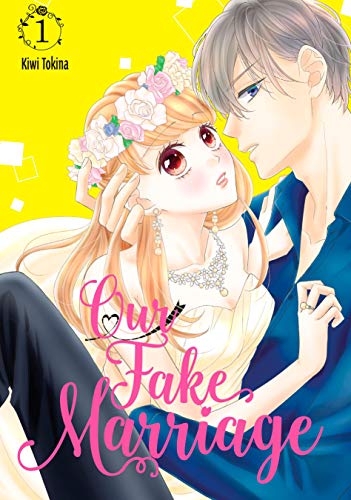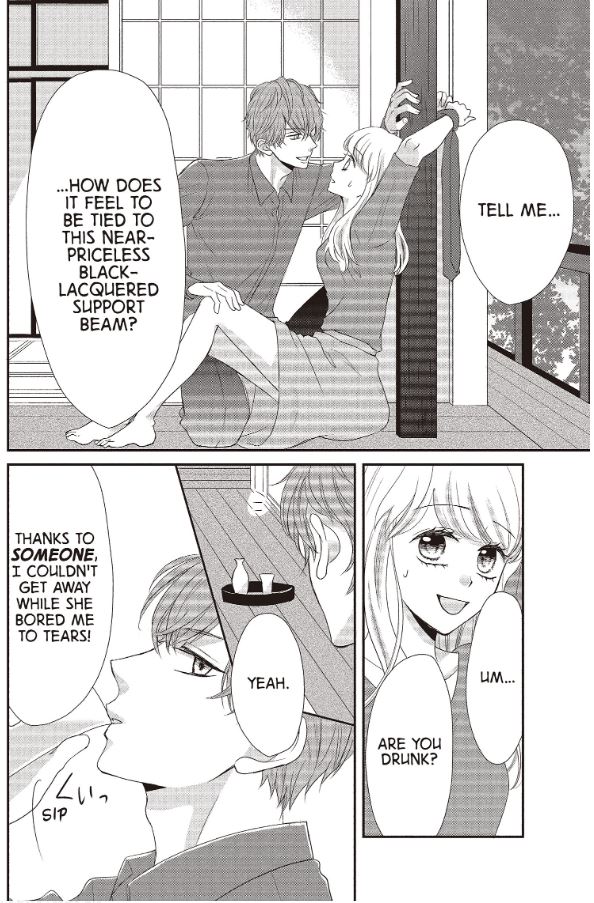
Now that I have a blog to run and a passion to fund, I’m always looking for sales and special deals on manga or light novels that I can read and review on this blog. Book Walker had a sale a while ago that included a bunch of manga that I haven’t had the chance to read, many of them romances, so I decided to try some out and see how it goes. One of these series is Our Fake Marriage by Kiwi Tokina. I picked up the first volume during the sale since it kind of seemed like something I might like, but I found fairly quickly that while I do like the more josei focus or relationships between older people, I did not like the main love interest at all. I think that might have been the point the mangaka was going for, to create a story around a fairly sleazy male lead, but it doesn’t do enough to break out of its problematic relationship for me to feel comfortable reading more.
Our Fake Marriage is about a woman named Yae who works temp jobs for a living. After her roommate kicks her out of their apartment to move her boyfriend in and she loses her part-time job, she finds herself homeless and jobless at 29 years old. After a chance encounter puts her face to face with her childhood friend, now a successful and handsome architect, she’s offered a place to live…for a price. In exchange she has to play the part of his wife in an effort to deter the women who seem to love to hang all over him. But will this job be more than she can handle?

In terms of art, I don’t really have much issue with Tokina’s style. It reminds me a bit of Maki Enjoji’s (Incurable Case of Love, Happy Marriage?!) in the way that the faces and eyes are drawn and the light use of value and contrast. It’s very much designed to look and feel like a light-hearted romance read, which goes along with its josei/comedy genre. Tokina hardly ever uses black or darker values, except for in coloring hair or the occasional black background. In the end, I don’t think the lack of values and contrast really matters considering the kind of content and story she’s trying to write here, but it would make for a more visually appealing manga overall.

What Tokina doesn’t accomplish with values and shading, I think she does with panel and character design. We very quickly get a sense of the character’s personalities by their general design. Yae has a very round face with huge eyes that gives her a very open and innocent perception of her character. In contrast, Takumi has a fairly slim and angular face with narrow eyes and a tousled hair style. This, when compared to other male protagonists in shoujo and josei, makes me think of him as a kind of sleazy, pretty-boy character. As the manga goes on, we definitely get the sense that these impressions are true. Tokina pairs this aspect with panel design to highlight and give space to the rest of the story, making sure to not crowd the page with dialogue and interspersing large and small panels to give the page a lighter feel.

Art can be a great draw for many readers, who see cute or glamorous looking characters on a cover and think, yea this could be a good series. And in many ways, I get caught up in that too. I definitely saw this and thought it might be a cute or light-hearted romance, but once I really got into it, I found I had more cons than pros. Shoujo and josei have a lot of issues with the kind of tropes they wind up using sometimes, tropes that can be problematic if they’re not handled correctly. There are times where we can say this isn’t much of a problem because we as adults know the difference between fact and fiction, but I think it’s about time we step back and ask, “Do we really need them any more? What value are they adding to the genre as a whole?” Bodice ripping romances can be fun sometimes, but even the long-time prose romance genre is moving away from these objectionable story lines to other, healthier stories.

Our Fake Romance uses a lot of common tropes found in shoujo and josei stories: girl/woman forced to live together with another person/man; the rich, high-class love interest with no concept of restraint; the fake relationship that slowly becomes real; the on the cusp of 30 woman who feels pressured into a relationship by society. I have no problem with many of these plots as long as they are used in a constructive and entertaining manner. However, this series uses all of these to force a 29-year-old woman into an abusive relationship with no tangible way of leaving. Tokina creates a scenario in which Yae has no money, no home, no job, nowhere to go and is given an offer that puts a roof over her head. The downside to this offer is that she’s stuck living with a man who repeatedly forces himself on her and sexually harasses her every chance he gets alone with her. Takumi also displays jealous and territorial tendencies towards the attentions of other men and Yae. All of this adds up to an extremely unhealthy dynamic, and I don’t think we’ll see a change in the story or Yae’s character that puts Takumi in his place.

Tokina admits in her asides throughout the manga that she created Takumi to be a sleaze-ball character, but to what end? I’ve seen stories like this play out time and time again, and it almost always winds up with the female protagonist eventually falling for the male despite his terrible and abusive behavior. Often it is twisted into the male lead just being misunderstood and not able to properly express his feelings, hiding them behind a womanizing facade. I get the feeling that we’ll see this happen here with Takumi considering they were childhood friends and he admits during this volume that she was his first love. But this shouldn’t excuse his behavior, and he shouldn’t be rewarded for his behavior with Yae’s love at the end of all of this. It creates a dangerous and toxic backbone for a story that is supposed to be comedic and romantic.
All in all, I can’t see myself reading another volume, and I wish more shoujo and josei mangaka would move away from rewarding toxic masculinity with their female lead’s love. We should be trying to promote healthy and loving relationships and not ones that are centered on abuse. So many women are hurt by these types of men, and I think romantic fiction should be a place for comfort, healing, and fun.
If you have read this series as well, let me know what you thought in the comments below. Did you have the same problems I did? Or the opposite? I’d love to hear your thoughts.
~~Thanks for Reading!~~
Follow me on Facebook, Twitter, and WordPress for all Bloom Reviews content updates and news!
If you like what I do, consider supporting me on Ko-fi or Patreon.


My biggest peeve with the series is Takumi is really hard to understand. Even when it seemed like I got his thought process, the author’s notes would come and go, “Nah, that’s not right!”
LikeLiked by 1 person
Yea I feel like the whole misunderstood playboy angle can be really hard to do right.
LikeLiked by 1 person
Ooof, I remember reading these kinds of shoujo/josei stories by the bagful in high school and just casually ignoring all those questionable tropes. Now I’m a bit older, I just can’t read them without going 🤨 and squicking out. It usually feels like it’s going to get worse before better (if even does!)
LikeLiked by 1 person
Yea definitely. I used to read a ton of them too, now I just can’t stand them
LikeLiked by 1 person
It is indeed hard to find good josei /shoujo mangas with a good plot , well they are similar yet only few know how to deal with the story in a way that makes sense , even if there is a bit of fiction things should be in order and reasonable like in happy marriage or in black bird or in tsubaki no lonely planet these stories are a perfect example ..but still there are many others
LikeLiked by 1 person